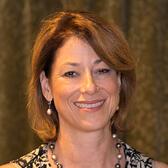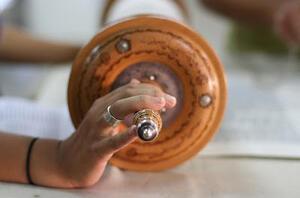A Dance on the Bimah
I sensed some apprehension in the sanctuary as we settled into our seats for Rosh Hashanah services. The congregation was experiencing a first: following the retirement of our long-time senior rabbi last spring, a woman was leading the clergy for the first time in congregational history. Joining her on the bimah was our second rabbi, also a woman. I knew there were some in the congregation who wondered what it would be like to begin this new year without male leadership at the top.
I myself had known only the model of a male senior rabbi: I had studied with our outgoing rabbi when I was converting to Judaism, and then again, thirteen years later, when I became an adult bat mitzvah. He counseled me, celebrated my children’s simchas, and handed me tissues through a painful divorce. He shaped my Jewish knowledge and identity. I felt a personal and spiritual loss when he retired.
But, as a JWA staff member, I had been looking forward to this new chapter in my congregation’s life since working on JWA’s Women Rabbis collection. I have been so moved by the revelatory, intimate, and often raw stories of women who have broken the “stained-glass ceiling” over the past four decades—and who, despite differences in denomination, geography, and eras, have experienced similar challenges and breakthroughs as they entered into the rabbinate.
In addition to the very specific story these pioneers tell of entering and transforming an ancient male profession, they also speak of experiences common to so many women: juggling roles as working mothers, care-taking daughters, professionals encountering gender bias in the workplace, women trying to make time for their partners, friends, and interests—all while meeting the demands of a consuming job.
Since listening to these stories in JWA’s collection, I have been made aware of how much harder women in the rabbinate have had to work to overcome bias. In this traditional profession, longstanding hierarchy and power structures have needed to shift radically to make room for more women and for new styles of leadership. Needless to say, the shift hasn’t always been easy or smooth—and it’s still a work in progress.
So it was with particular excitement and curiosity that I awaited our new leadership and its very public debut during the High Holidays. And that debut turned out to be more extraordinary than I could have imagined. From where I sat, I felt like we were experiencing a fresh, exhilarating take on ritual practice and on leadership. I’ve attended countless services at which women rabbis have played a role, but they are often subordinate to a senior rabbi who is male. Here, there was no sense of hierarchy; instead, I watched as the two women rabbis punctuated the choreography of the service with hugs as they passed one other, and exchanged nonverbal messages of support and teamwork. It was a marvelous dance—seamlessly intertwined and palpably warm. I realized I was watching joyful, effortless, female collaboration on the bimah.
After hearing some of the first women rabbis recount their bumpy journeys to the rabbinate in the JWA collection, I am more attuned to just how much work has gone into making leadership like my rabbis' seem effortless. Seeing it in action during these High Holidays—and witnessing a female-centric and synergistic approach to ritual observance—was a thrill. I found myself silently cheering on the rabbis as they introduced new elements to the service, used humor and warmth to negotiate inevitable glitches, traded off performing traditional roles, and gave extraordinary sermons. I hoped everyone else sitting in the sanctuary was appreciating the dance as much as I was, and was asking themselves: What took us so long?
Like their coordinated interaction on the bimah, the rabbis’ sermons were intertwined as well. On erev Rosh Hashanah, one spoke of Judaism’s (and our individual) adaptability to change; the next day, the other emphasized the need for inclusion in the congregation and the community. These are not new values for the congregation, or for Reform Judaism, but the back-to-back sermons felt like an opening salvo, a declaration that we would actually do the necessary work over the coming year. These women rabbis’ very presence, as well as the choices they had made for the services and the messages they chose to emphasize, bore out the values they were calling on us to enact. We’re not going to just pay lip service, they seemed to say. We’re going to live these values. Starting with the two of us here, now, on this bimah.
In each of their sermons, the two rabbis referenced the world they want to see and help shape for their sons. Lucky boys, I thought, to have such strong role models in their mothers.
And then, looking around at the rapt faces and nodding heads of my congregation, I thought how important it also is for adult men, as well as for us women, to have powerful female role models like these. Lucky all of us.








Rachel, thank you for this beautiful and very apt description of a wonderful experience at our synagogue. I completely agree with you and was especially thrilled to see the expressions of inclusivity during the holidays -- I wrote about it here: http://www.edmundcase.com/inclusion-and-welcoming/letters-in-the-scroll…; We've got two rabbis who "get it" and are very fortunate.
Every new voice brings a fresh perspective to the Torah. This year, hearing the voices of these wonderful rabbis caused me to see the days of awe anew. Thanks, Rachel, for putting it into words.
Beautifully worded and so true. Happy for our Temple Shalom family who enjoyed, accepted, realized and loved this transition.
I'm with you 100%! I'm still feeling the joy of those services. Thank you for sharing.
Yes. Yes! YES!